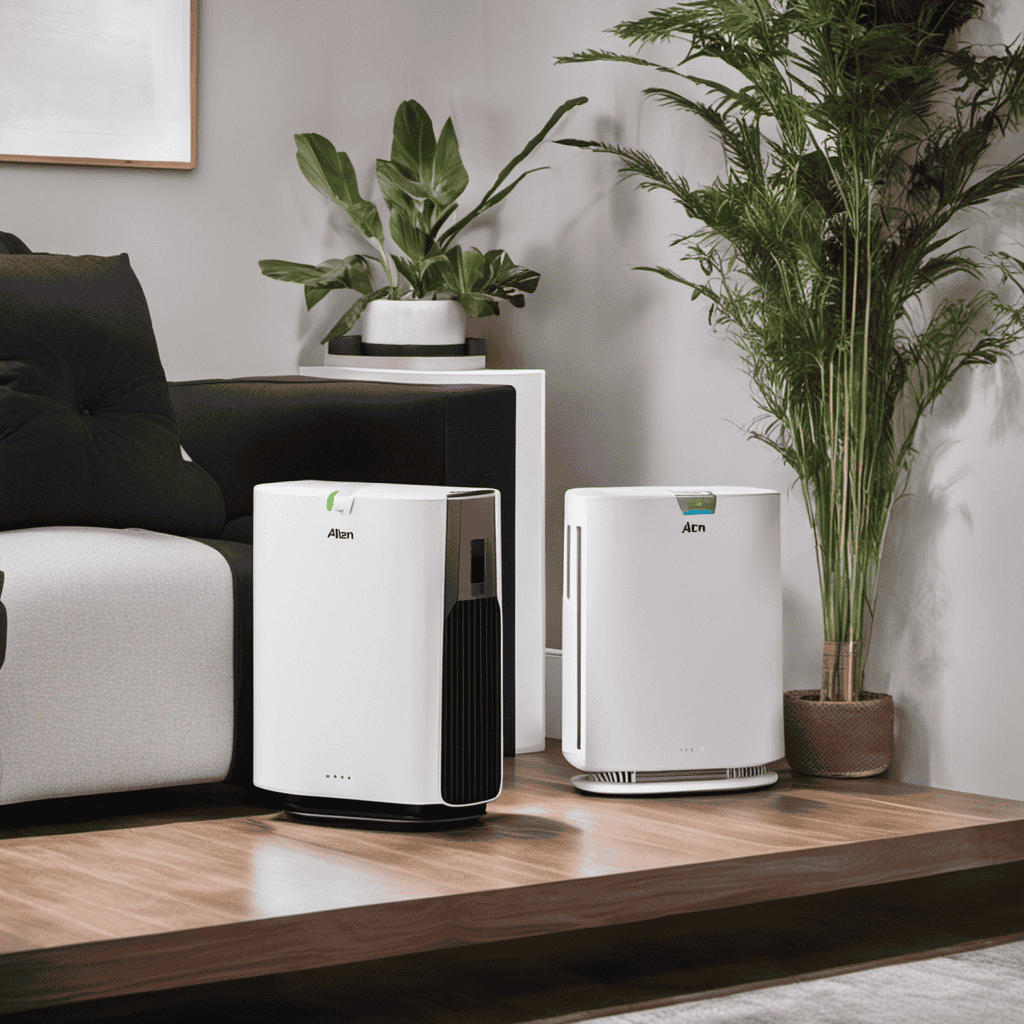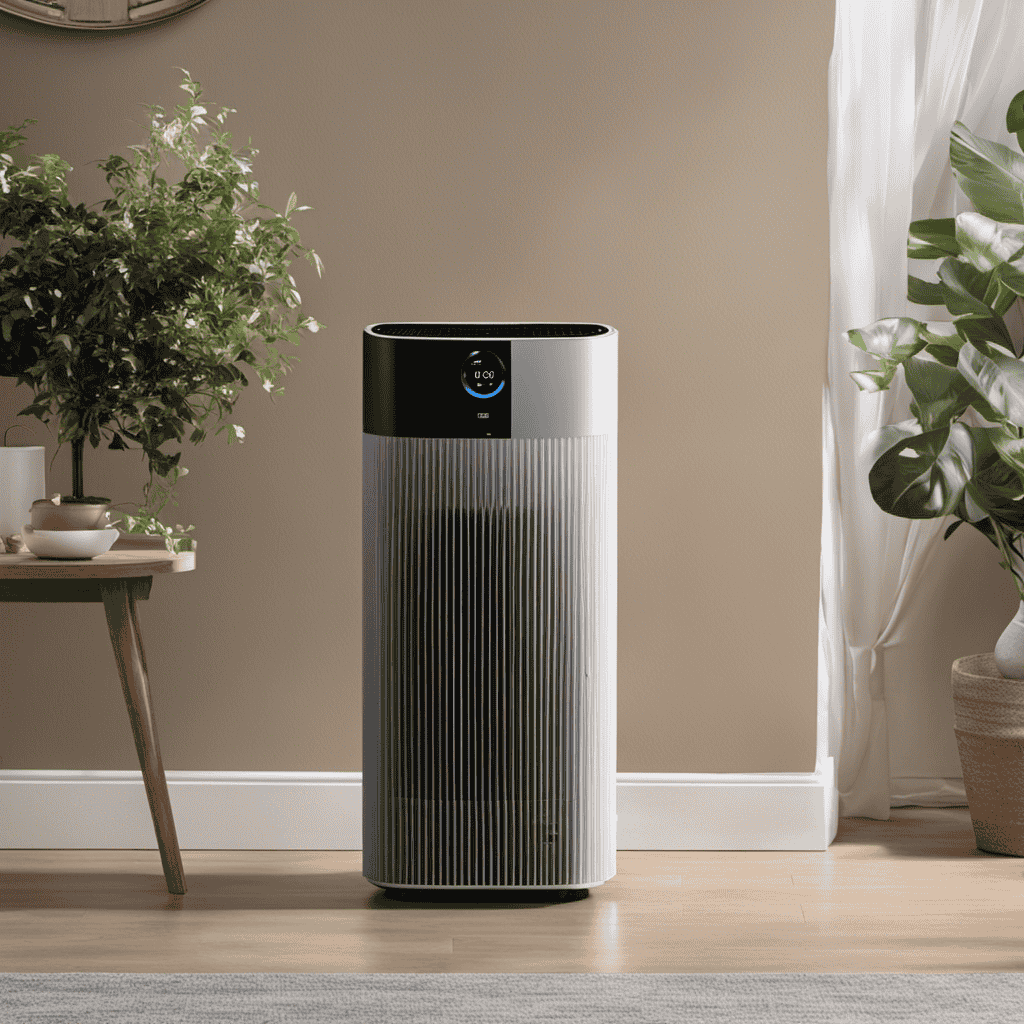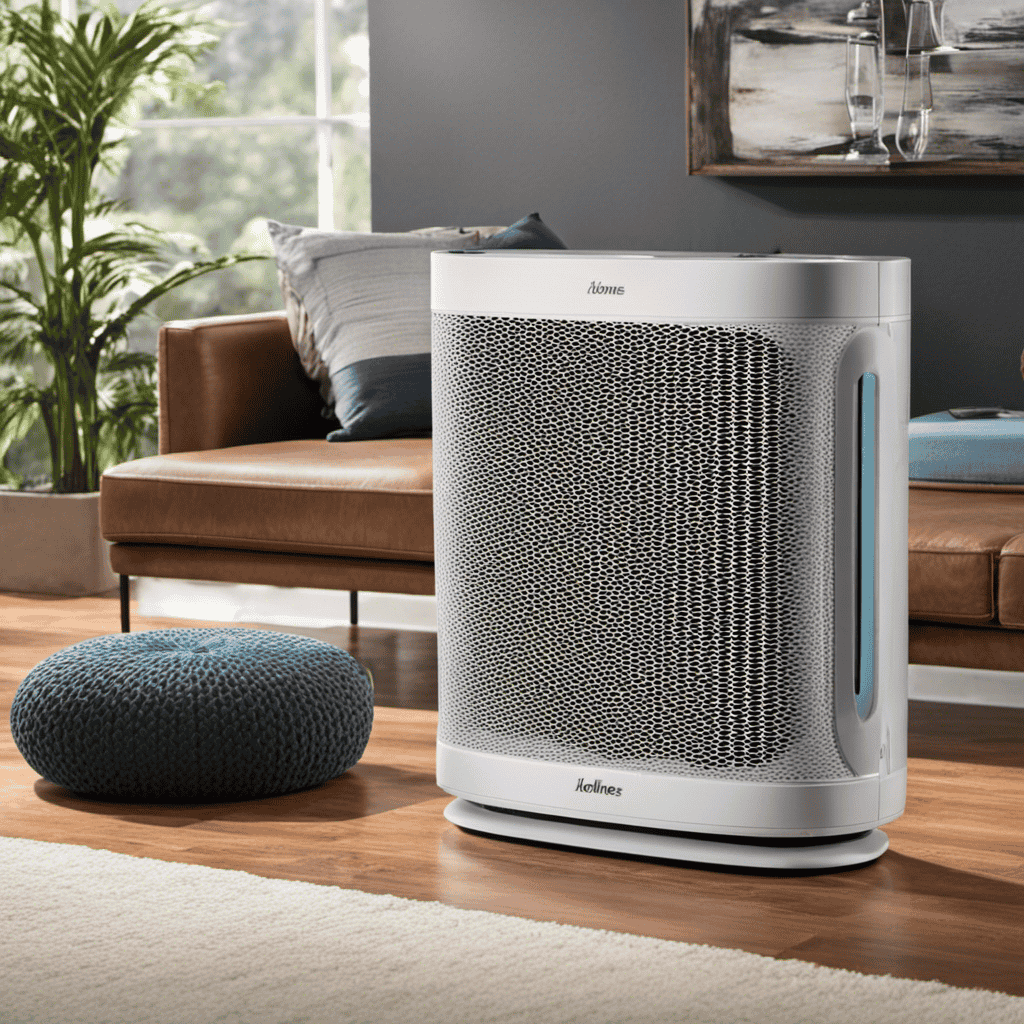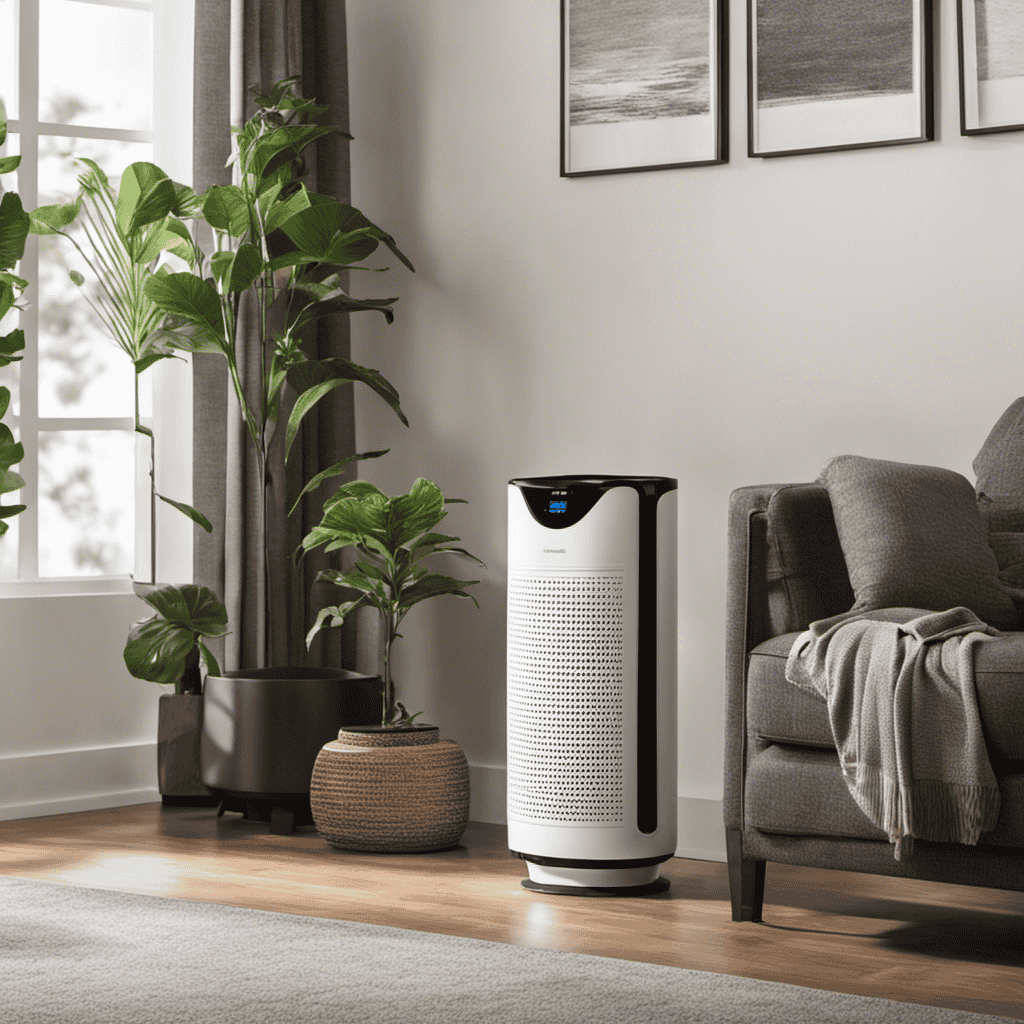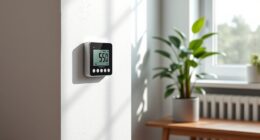As an individual who has dealt with asthma for a long time, I empathize with the ongoing struggle to discover effective ways to control and relieve symptoms.
Did you know that approximately 25 million people in the United States alone suffer from asthma?
In this article, we will explore the effectiveness of dehumidifiers versus air purifiers in controlling asthma triggers.
By understanding the role of humidity and the benefits of these devices, we can make informed decisions for better asthma management.
Key Takeaways
- Asthma affects approximately 25 million people in the United States.
- Controlling humidity levels between 30% and 50% is crucial for managing asthma triggers like mold and dust mites.
- Dehumidifiers reduce moisture in the air and prevent the growth of mold and dust mites, alleviating asthma symptoms.
- Air purifiers filter out pollutants and allergens from the air, improving indoor air quality and creating a healthier environment for asthma sufferers.
Understanding Asthma and Its Triggers
If you have asthma, it’s important to understand what triggers it and how to manage those triggers effectively.
Asthma triggers are things that can cause your airways to become inflamed and constricted, leading to symptoms such as wheezing, coughing, and difficulty breathing. Common triggers include allergens like pollen, dust mites, and pet dander, as well as irritants like tobacco smoke, air pollution, and strong odors.
Managing asthma triggers involves identifying and avoiding them as much as possible. This may include keeping your home clean and free of dust, using mattress and pillow covers to protect against dust mites, and avoiding exposure to cigarette smoke.
It’s also important to take any prescribed medications as directed by your healthcare provider to help control your asthma symptoms. By understanding and managing your asthma triggers, you can reduce the frequency and severity of asthma attacks and improve your overall quality of life.
The Importance of Controlling Humidity Levels
To properly manage your indoor air quality and reduce triggers, it’s crucial for you to control the humidity levels in your home. Controlling humidity levels can have numerous benefits for your health and overall comfort. By maintaining an optimal humidity range, typically between 30% and 50%, you can prevent the growth of mold, dust mites, and other allergens that thrive in high humidity environments. Additionally, managing humidity levels can help alleviate respiratory symptoms, such as coughing and wheezing, common in conditions like asthma. To help you understand the impact of humidity on your indoor air quality, here is a table that illustrates the effects of different humidity levels:
| Humidity Level | Effects |
|---|---|
| Below 30% | Dry skin, irritated eyes, increased static electricity |
| 30%-50% | Optimal range for comfort and health |
| Above 50% | Increased risk of mold growth, dust mites, and other allergens |
The Role of Dehumidifiers in Managing Asthma
Controlling the humidity levels in my home can greatly benefit my respiratory health, allowing me to manage my asthma symptoms more effectively. One of the tools that can help in managing asthma is a dehumidifier.
A dehumidifier works by reducing the moisture in the air, which can help prevent the growth of mold and dust mites, both of which are common triggers for asthma attacks. By reducing these triggers, a dehumidifier can help manage allergies and improve indoor air quality.
In addition, a dehumidifier can also help alleviate symptoms like coughing, wheezing, and shortness of breath. It is important to keep the humidity levels between 30-50% to ensure the best results.
Overall, incorporating a dehumidifier into my asthma management plan can provide me with the benefits of clean air and help alleviate my symptoms.
How Air Purifiers Can Help Alleviate Asthma Symptoms
When it comes to managing asthma symptoms, air purifiers can provide significant benefits. These devices are designed to filter out pollutants and allergens from the air, which can help improve indoor air quality and reduce asthma triggers.
Air purifiers can be particularly effective in removing common asthma triggers such as dust mites, pet dander, and pollen. However, it’s important to note that while air purifiers can help alleviate asthma symptoms, they are not a substitute for proper medical treatment and should be used in conjunction with other asthma management strategies.
Air Purifier Benefits
You’ll love the benefits of an air purifier for asthma. They can provide cleaner indoor air and reduce allergens. Air purifier technology plays a crucial role in improving air quality. It works by removing airborne particles and pollutants that can trigger asthma symptoms. These devices use filters or other advanced technologies to capture and eliminate allergens, dust, pet dander, and other irritants from the air. By effectively purifying the air, they can help reduce the presence of asthma triggers and create a healthier environment for asthma sufferers.
Air purifiers can also help decrease the risk of respiratory infections and improve overall respiratory health. They have the ability to remove harmful particles from the air, making them an essential tool in managing asthma symptoms and enhancing indoor air quality.
Asthma Symptom Relief
One effective way to relieve symptoms of asthma is by using an inhaler prescribed by your doctor.
Asthma triggers can vary from person to person, but common triggers include allergens such as dust mites, pet dander, pollen, and mold.
Managing humidity levels in your home can also help alleviate asthma symptoms. High humidity can promote the growth of mold and dust mites, which can worsen asthma symptoms. Using a dehumidifier can help reduce humidity levels and prevent the growth of these triggers.
It is important to keep the humidity in your home between 30-50%.
Additionally, regularly cleaning and vacuuming your home, using allergen-proof bedding, and avoiding tobacco smoke can further help manage asthma symptoms.
Remember to always consult with your doctor for personalized advice on managing your asthma.
Dehumidifier Vs. Air Purifier
If you’re trying to improve indoor air quality, it’s important to understand the differences between a dehumidifier and an air purifier.
Dehumidifiers are designed to reduce the moisture level in the air, which can help prevent mold growth and reduce allergens. They can also provide relief for individuals with respiratory conditions such as asthma by creating a drier environment.
On the other hand, air purifiers are designed to remove airborne particles, such as dust, pollen, and pet dander, from the air. They use filters and other technologies to trap and eliminate these particles, improving the overall air quality.
Both dehumidifiers and air purifiers have their benefits, but they serve different purposes in improving indoor air quality.
Transitioning into the next section, let’s now compare the effectiveness of dehumidifiers vs. air purifiers in addressing asthma symptoms.
Comparing the Effectiveness of Dehumidifiers Vs. Air Purifiers
To determine which is more effective for managing asthma symptoms, consider how a dehumidifier can reduce moisture in the air and an air purifier can filter out allergens and pollutants.
When comparing the effectiveness of dehumidifiers and air purifiers for asthma management, it is important to consider the health benefits each option provides. Here are three key points to consider:
-
Reduced moisture levels: A dehumidifier helps to lower humidity levels in the air, which can prevent the growth of mold and dust mites, common triggers for asthma symptoms.
-
Allergen and pollutant removal: An air purifier is designed to remove allergens and pollutants from the air, such as pet dander, pollen, and smoke particles. This can significantly reduce asthma attacks and improve overall respiratory health.
-
Improved air quality: Both dehumidifiers and air purifiers contribute to cleaner and healthier air, which can greatly benefit individuals with asthma by reducing the likelihood of triggering symptoms.
Factors to Consider When Choosing Between a Dehumidifier and an Air Purifier
Now that we have compared the effectiveness of dehumidifiers and air purifiers in managing asthma, let’s discuss the factors to consider when choosing between the two. Both dehumidifiers and air purifiers have their own benefits and it is important to understand these factors before making a decision.
| Factors to Consider | Benefits of Dehumidifiers | Benefits of Air Purifiers |
|---|---|---|
| Air moisture level | Reduces moisture in the air, preventing the growth of mold and dust mites | Filters out allergens, such as pollen, pet dander, and dust |
| Asthma triggers | Controls humidity levels, reducing the risk of asthma triggers | Removes airborne particles that can trigger asthma symptoms |
| Maintenance | Requires regular cleaning and maintenance | Requires filter replacement |
| Cost | Initial cost is lower, but may consume more energy in the long run | Higher initial cost, but lower energy consumption |
When deciding between a dehumidifier and an air purifier, consider factors such as the air moisture level, asthma triggers, maintenance requirements, and cost. Dehumidifiers are effective in reducing moisture and controlling asthma triggers, while air purifiers excel at filtering out allergens. Additionally, dehumidifiers require regular maintenance and may have higher long-term energy consumption, while air purifiers require filter replacement but have lower energy consumption. Choose the option that best suits your specific needs and budget.
Finding the Right Dehumidifier for Asthma Relief
When considering options for managing asthma relief, it’s important to find the right dehumidifier. Dehumidifiers help reduce the moisture in the air, which can help alleviate asthma symptoms by preventing the growth of mold and dust mites.
Here are three important factors to consider when choosing the best dehumidifier for asthma relief:
-
Capacity: Look for a dehumidifier with a capacity suitable for the size of the room where it will be used. It should be able to remove the right amount of moisture to maintain the ideal humidity level.
-
Noise level: Consider the noise level of the dehumidifier, especially if it will be used in a bedroom or living area. Look for models with quiet operation to ensure a peaceful environment.
-
Energy efficiency: Opt for an energy-efficient dehumidifier to save on electricity bills. Look for models with an Energy Star rating, which indicates that they meet strict guidelines for energy efficiency.
Selecting the Best Air Purifier for Asthma Management
Consider factors such as size, noise level, and energy efficiency when selecting an air purifier for managing your asthma symptoms.
Air purifiers can be an effective tool in reducing indoor air pollutants that can trigger asthma attacks.
When selecting an air purifier, it is important to choose one that is the right size for the room you plan to use it in. A purifier that is too small may not effectively clean the air, while one that is too large may be wasteful and inefficient.
Additionally, consider the noise level of the purifier, as loud noises can be disruptive or even trigger asthma symptoms.
Finally, look for an energy-efficient model to minimize energy consumption and lower your carbon footprint.
Is Using an Air Purifier More Effective Than a Dehumidifier for Managing Asthma Symptoms?
When managing asthma symptoms, using an air purifier can be more effective than a dehumidifier. Air purifier benefits for sleep include removing airborne irritants like dust and pet dander that can trigger asthma symptoms. This can lead to better quality sleep and improved overall health for asthma sufferers.
Implementing a Comprehensive Approach to Asthma Control
To effectively manage your asthma symptoms, it’s important to implement a comprehensive approach that includes monitoring triggers, taking prescribed medications, and regularly visiting your healthcare provider. This comprehensive approach is crucial for achieving and maintaining asthma control.
Here are three key elements that are essential in this approach:
-
Trigger monitoring: Identifying and avoiding triggers that can worsen your asthma symptoms is vital. By keeping track of your triggers, such as pollen, dust mites, or pet dander, you can take proactive steps to minimize exposure and reduce the likelihood of an asthma attack.
-
Medication adherence: Following your prescribed medication regimen consistently is crucial for asthma control. Whether it’s a daily controller medication or a rescue inhaler for acute symptoms, taking your medications as directed can help prevent and manage asthma flare-ups.
-
Regular healthcare visits: Visiting your healthcare provider on a regular basis is important for monitoring your asthma and adjusting your treatment plan as needed. Your provider can assess your symptoms, perform lung function tests, and provide guidance on managing your condition effectively.
Conclusion
In conclusion, when it comes to managing asthma, the choice between a dehumidifier and an air purifier is like deciding between a cool ocean breeze and a gentle rainfall.
Both options play a crucial role in alleviating asthma symptoms by controlling humidity levels and removing allergens from the air.
However, finding the right solution depends on individual needs and preferences.
By implementing a comprehensive approach that combines the power of both devices, asthma sufferers can create a harmonious environment that breathes new life into their lungs.

